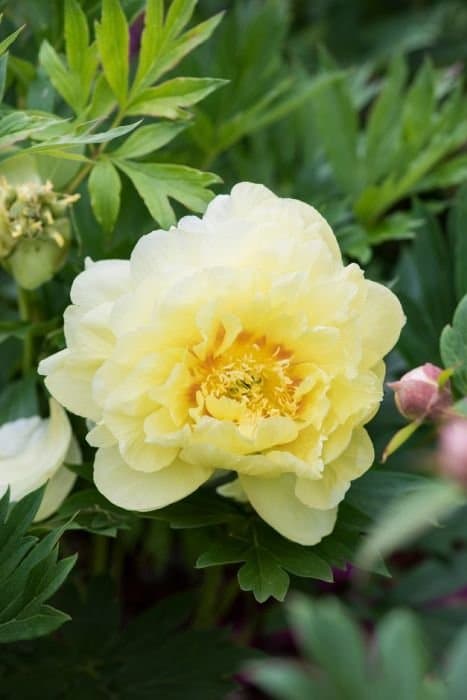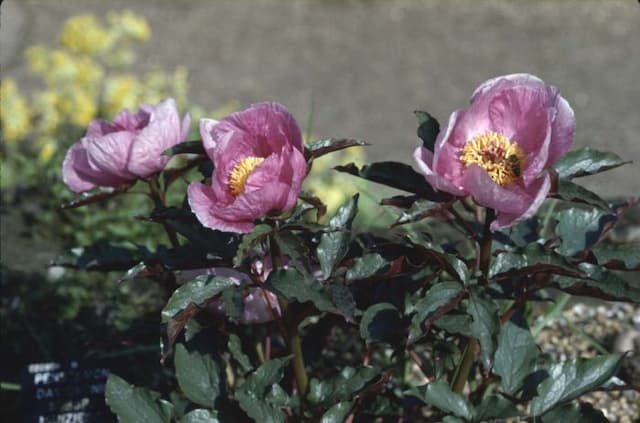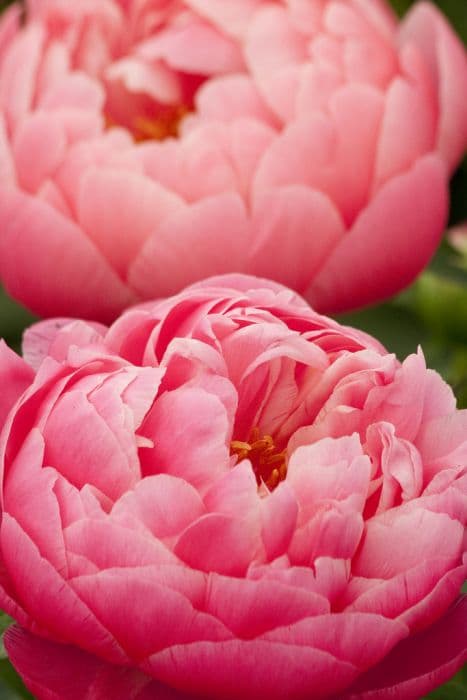Peony Paeonia lactiflora 'Kansas'

ABOUT
The plant known commonly as 'Kansas' peony features a lush display of large, vibrant double blossoms that are a deep, plush pink. These richly colored flowers emit a delightful fragrance, contributing to their popularity in gardens and as cut flowers. The individual blooms present multiple layers of ruffled petals, creating a full and rounded appearance that's visually striking. The foliage of the 'Kansas' peony is deep green, forming an attractive backdrop to the spectacular flowers during their blooming season. The leaves are divided into leaflets with a somewhat glossy surface and a naturally attractive shape that complements the overall aesthetic beauty of the plant. As a perennial, this peony variety emerges annually to showcase its blooms, which typically appear in late spring to early summer, offering a burst of color and sweetness to any space it inhabits.
About this plant
 Names
NamesFamily
Paeoniaceae
Synonyms
Chinese Peony, Common Garden Peony, White Peony
Common names
Paeonia lactiflora 'Kansas'.
 Toxicity
ToxicityTo humans
Peony is generally considered safe for humans when touched or ingested in small quantities. However, eating large amounts of the plant, particularly the roots, may lead to gastrointestinal upset including nausea, vomiting, and diarrhea.
To pets
Peony may cause mild discomfort in pets if ingested, potentially resulting in gastrointestinal upset, such as vomiting or diarrhea. While the risk of severe toxicity is low, pets showing any adverse symptoms after consuming peony should be monitored closely and may require veterinary care.
 Characteristics
CharacteristicsLife cycle
Perennials
Foliage type
Deciduous
Color of leaves
Green
Flower color
Red
Height
2-3 feet (60-90 cm)
Spread
2-3 feet (60-90 cm)
Plant type
Herb
Hardiness zones
3-8
Native area
Asia
Benefits
 General Benefits
General Benefits- Aesthetic Appeal: The Paeonia lactiflora 'Kansas', commonly known as Peony 'Kansas', offers stunning, large, double-form flowers with deep pink hues that can enhance the beauty of any garden.
- Attracts Pollinators: The vibrant flowers attract bees and butterflies, which are beneficial for pollination of garden plants and the broader ecosystem.
- Longevity: Peonies are known for their long life span, often living for decades and becoming a permanent fixture in a garden.
- Seasonal Interest: Peonies provide seasonal interest with their late spring to early summer blooming period, when few other plants are in flower.
- Cut Flowers: The robust and beautiful blooms make excellent cut flowers for arrangements and last well in vases.
- Minimal Maintenance: Once established, Peonies require minimal care, making them a convenient choice for gardeners of all levels of experience.
- Cold Tolerance: Peonies are hardy to cold temperatures, making them suitable for gardens in cooler climates.
- Deer Resistance: These plants are not a preferred food source for deer, which can help limit damage to the garden.
 Medical Properties
Medical Properties-
This plant is not used for medical purposes.
 Air-purifying Qualities
Air-purifying QualitiesThis plant is not specifically known for air purifying qualities.
 Other Uses
Other Uses- Peony 'Kansas' petals can be used to create natural plant dyes, offering a range of colors from soft pinks to rich burgundies depending on the mordant used.
- The blooms can serve as an organic source of pigment for eco-friendly textile practices, enticing artisans seeking sustainability.
- Dried peony petals can add a pop of color and a subtle fragrance to homemade potpourris and sachets.
- These peonies can be used for floral art, such as pressing the petals for bookmarks or framed art pieces.
- Flower enthusiasts use the petals for crafting homemade soaps, adding both color and a hint of fragrance to the final product.
- Peony 'Kansas' can be incorporated into culinary presentations, with petals adorning cakes and pastries for an elegant touch.
- In the garden, peonies can act as support plants for weaker-stemmed neighbors, providing a natural stake as they have sturdy stems.
- The plants can serve as an indicator of the changing seasons in a garden, as they are known for their timely blooming in late spring.
- Leaves from the peony 'Kansas' can be used in artistic projects or eco-printing techniques to transfer the leaf patterns onto fabrics or paper.
- During blooming season, the flowers can be a valuable food source for pollinators such as bees and butterflies.
Interesting Facts
 Feng Shui
Feng ShuiPeonies, including Paeonia lactiflora 'Kansas', are commonly used in Feng Shui to promote love and romance. They are often placed in the love and marriage corner of the home, which is the southwest sector, to enhance the energy related to relationships.
 Zodiac Sign Compitability
Zodiac Sign CompitabilityThe Peony is not used in astrology practice.
 Plant Symbolism
Plant Symbolism- Prosperity: Paeonia lactiflora 'Kansas', commonly known as the Peony 'Kansas', is often associated with prosperity and is considered good luck for earning wealth.
- Romance: The lush, full blossoms of the peony symbolize romance and love, making it a popular choice for weddings and romantic occasions.
- Beauty: The peony's attractive appearance lends itself to symbolize beauty in various cultures, often linked to a sense of charming allure.
- Honor: Peonies are seen as a token of honor and high esteem, embodying respect and appreciation when given as gifts.
- Wealth: Beyond prosperity, peonies are also believed to attract wealth, leading to their inclusion in celebrations and decorations that focus on financial success.
- Good Fortune: Peonies are symbols of good luck, especially in terms of positive future prospects and fortuitous opportunities.
- Compassion: In certain cultural contexts, the peony represents compassion and empathy, possibly due to its lush, nurturing appearance.
- Bashfulness: According to one legend, nymphs were believed to hide within peony petals, which has made the flower a symbol of shyness or bashfulness.
- Happiness: The vibrant and bountiful blossoms of the peony convey a message of joy and happiness, often seen during joyous celebrations.
- Healing: Peonies have been used in traditional medicine, and as such, they are commonly associated with healing and are thought to bring about good health.
 Water
WaterThe Peony 'Kansas' should be watered deeply once every week during the spring and summer months, ensuring that the soil is thoroughly moistened. During hot, dry spells, you may need to water twice a week. Each watering session should provide the peonies with about one inch of water, which is roughly equivalent to 0.6 gallons for a small plant. This amount could vary based on plant size and the soil's ability to retain water. Overwatering or allowing the plants to sit in water can lead to rot, so ensure the soil drains well and dries out slightly between watering sessions.
 Light
LightPeonies like 'Kansas' flourish in a spot that provides full sun to partial shade. They need at least six hours of sunlight each day to produce their best blooms. The ideal location would be an area that receives morning sunlight and is protected from the harshest afternoon rays, although peonies are quite adaptable and can tolerate more sun if necessary.
 Temperature
TemperaturePeonies such as 'Kansas' are hardy and can tolerate cold winters, with a survival range down to -20°F, but they perform best where summers are not excessively hot. They prefer a temperature range between 65°F and 75°F during their growing season. It's critical for the peonies' health to experience a period of winter chilling, at least 30 days with temperatures below 40°F, which is necessary for bud formation.
 Pruning
PruningPrune Peony 'Kansas' plants in fall after the foliage has died back. This pruning is primarily for removing dead or spent leaves and stems, which helps to reduce the likelihood of fungal diseases. Prune the stems down to just above the soil line. Peonies do not require pruning for shaping or to encourage blooming like some other perennials might, so once-a-year cleanup is sufficient.
 Cleaning
CleaningAs needed
 Soil
SoilPeony 'Kansas' thrives in well-draining, fertile soil with a pH of 6.5-7.0. A mix of loamy soil, compost, and perlite or vermiculite can provide the ideal texture and nutrients needed for optimal growth.
 Repotting
RepottingPeonies like 'Kansas' are not typically repotted as they are perennial plants that prefer to be left undisturbed. They should be divided every 5 to 10 years in the fall if growth slows or crowding occurs.
 Humidity & Misting
Humidity & MistingPeony 'Kansas' is tolerant of a wide range of humidity levels and does not require any special humidity considerations, as it is well-adapted to outdoor conditions in its growing zones.
 Suitable locations
Suitable locationsIndoor
Peonies like 'Kansas' rarely thrive indoors; focus on garden planting.
Outdoor
Plant peony 'Kansas' in full sun, rich soil, and water well.
Hardiness zone
3-8 USDA
 Life cycle
Life cyclePaeonia lactiflora 'Kansas', commonly known as the Kansas Peony, begins its life cycle when seeds are sown and undergo a period of stratification, requiring chilling to break dormancy. After germination, the plant develops a root system and foliage as a juvenile, which then matures into a clump-forming herbaceous perennial. Once established, it enters a growth phase each spring, producing large, deeply lobed leaves and stems that rise up to 2-3 feet tall. The Kansas Peony reaches a reproductive stage in late spring to early summer, producing large, double-form, bright crimson flowers that are fragrant and attractive to pollinators. After blooming, seed pods may form, which, when mature, release seeds to complete the reproductive cycle. In autumn, the plant's foliage dies back to the ground, and the peony enters dormancy, conserving energy in its underground tuberous roots to survive the winter and regrow the following spring.
 Propogation
PropogationPropogation time
Late Fall
The most common method of propagating the peony 'Kansas' is by division. The ideal time to propagate peonies by division is in the fall after the plants have gone dormant, typically from late September to October. When dividing, carefully dig up the clump of the peony, making sure to maintain as much of the root system as possible. Cleanly cut the clump into smaller sections, each with at least three to five eyes, which are the pink or white shoots where the new growth will emerge. Divisions should then be planted in well-drained soil at a depth where the eyes are only about 1 to 2 inches (2.5 to 5 cm) below the soil surface, as planting them too deeply can inhibit flowering. It's crucial to water the newly planted divisions thoroughly to help establish them. With proper fall planting, peonies will have ample time to establish roots before the onset of winter, leading to successful growth in the spring.









